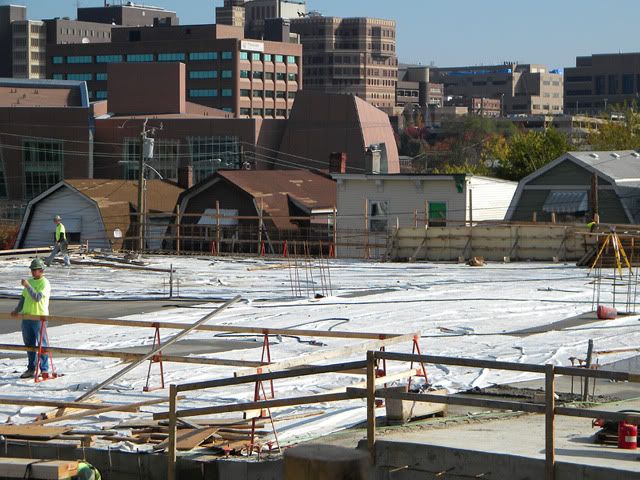 "Cincinnati is a miraculous city," Cincinnati Mayor Mark Mallory said during his 2010 State of the City Address, delivered last Wednesday evening. "We get kicked around sometimes for not going out on a limb. We do not go out on extremes. We sort of steadily move along."
"Cincinnati is a miraculous city," Cincinnati Mayor Mark Mallory said during his 2010 State of the City Address, delivered last Wednesday evening. "We get kicked around sometimes for not going out on a limb. We do not go out on extremes. We sort of steadily move along."
This slow-and-steady approach has allowed Cincinnati to weather the economic storm better than many cities he said, making progress through a combination of public-private partnerships, investment in public infrastructure, and the attraction and retention of companies that create jobs.
"I am constantly in neighborhoods all over the city," Mallory said. "Sometimes I am breaking ground. Sometimes I am cutting ribbons. Sometimes I am meeting with community leaders, giving speeches, visiting schools."
To Mallory, that means that the City is building something – partnerships.
 'An impressive list'
'An impressive list'
Mallory said that these public-private partnerships have led to:
- Spring Hill Suites by Marriott in Walnut Hills, a partnership between the City and Humana that's part of the Baldwin 300 project;
- Hampton Inn in Corryville, part of the Corryville Crossings project;
- A new business park on the former NuTone site in Madisonville, including a new office building for Medpace and up to 800 jobs;
- Redevelopment of the Vernon Manor Hotel into an office building for 600 Cincinnati Children's Hospital Medical Center employees;
- Reconstruction of the Eighth Street Viaduct, a partnership between the City, county, state, and federal governments;
- The new MSD Wastewater Engineering Building, the most energy-efficient building ever constructed by the City;
- The new American Red Cross facility at Keystone Parke in Evanston, scheduled for completion this summer;
- A new Graeter's manufacturing facility in Bond Hill, recipient of a City loan;
- In Northside, 58 new houses built, under construction, or proposed as part of the Rockford Woods CitiRama, Northwind, and Fergus Street Homeownership projects;
- The Jimmy Heath House, 25 units of permanent supportive housing being built with Over-the-Rhine Community Housing and 3CDC for the chronically homeless in Over-the-Rhine;
- Woodburn Pointe, 24 units of new senior housing in Evanston, scheduled to open in summer 2011;
- A new LEED-pursuing Fire Station No. 51 ($3.8M) in College Hill;
- Dandridge Studio Town Homes, six condominium units that represent the first new housing constructed in Pendleton in over 100 years; and
- Greendog Café, a locally-owned restaurant in resulting from a partnership with Al. Neyer, Inc. at Columbia Square.
 Streetcar is a responsibility
Streetcar is a responsibilityMallory used his address to advance his vision for the Cincinnati streetcar project, an investment in public infrastructure that he said is one of the City's strategies to grow and expand the local economy.
"Previous generations of Cincinnatians felt a responsibility to do that as well," Mallory said. "They did it. In the 1870s, they built a railroad. We are the only city in the country that built a railroad for interstate commerce. And we still own it today."
That railroad, the Cincinnati Southern Railway, is leased to Norfolk Southern. The City receives between $18 million and $19 million annually from the lease.
"They built it to benefit Cincinnati’s future," Mallory said. "And we have the exact same responsibility, and that is why we are going to build a streetcar."
 Infrastructure as catalyst
Infrastructure as catalystAnother major public infrastructure investment is a $1 billion-plus sewer and wetlands project by the Metropolitan Sewer District of Greater Cincinnati that could revive Lick Run, a tributary of the Mill Creek that passes through South Fairmount.
"I do not normally get excited about sewer projects, but let me tell you, this one goes far beyond big pipes under the ground," Mallory said. "The project will recapture a natural waterway, it will transform South Fairmount and surrounding areas, and it will be the catalyst for investment and development in that area."
If done correctly, the project will provide economic, environmental, and quality of life improvements for decades to come, Mallory said.
"We have got to utilize the development and redevelopment of our public infrastructure to put people to work," he said.
 The City as a house
The City as a houseMallory closed his speech by emphasizing the concept of stewardship.
Comparing the City to a house, he referred to himself as a caretaker.
"People lived here before I did and people will live here after me," Mallory said. "But, just like with your house, you want to do things that will add value to the house. We have to make good investments that we know will add value to Cincinnati for future generations."
And we are, he said, by investing in such project as The Banks, our new tallest skyscraper, a new casino, and the streetcar.
"Previous generations of Cincinnatians did that, they took good care of this house," Mallory said. "They invested in this house. That is what it means to be a Cincinnatian. They invested in businesses. They invested in great hospitals and arts and cultural institutions. They invested in transportation and in our great neighborhoods."
And he urged the audience to do the same.
"Continue to be the caretakers of this house we love," Mallory said. "Be great Cincinnatians, and you will be a part of making us great."









